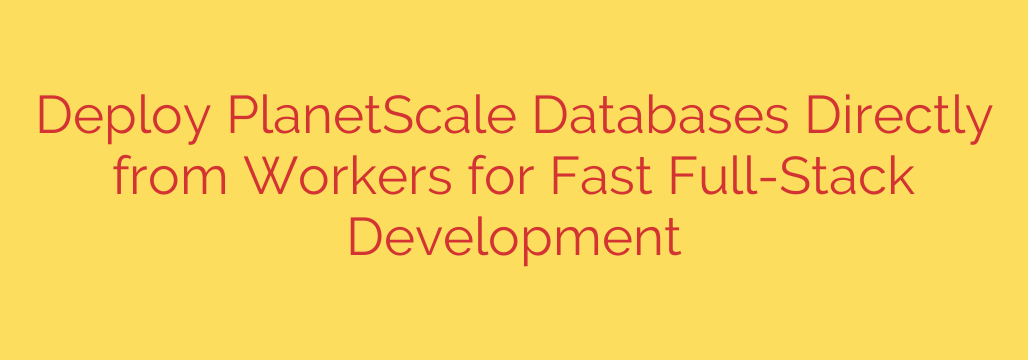
Unlock Blazing-Fast Full-Stack Apps: A Guide to PlanetScale and Cloudflare Workers
In the quest for faster, more scalable web applications, developers are increasingly turning to edge computing and serverless databases. The traditional model of a centralized database server communicating with globally distributed users is being challenged by a new architecture that brings both data and logic closer to the end-user. This modern approach dramatically reduces latency and simplifies infrastructure management.
One of the most powerful combinations leading this charge is PlanetScale and Cloudflare Workers. By integrating PlanetScale’s highly scalable, MySQL-compatible serverless database directly with Cloudflare’s global network of serverless functions, you can build and deploy full-stack applications with unparalleled performance and an exceptional developer experience.
Why This Combination is a Game-Changer
Connecting a database from a serverless function has historically been a complex task, often plagued by issues with connection pooling, latency, and security. The direct integration between PlanetScale and Workers solves these problems elegantly, offering a seamless path to building robust, globally-distributed applications.
Here’s why this duo is so effective:
- Unmatched Performance at the Edge: Cloudflare Workers run on a network that spans hundreds of cities worldwide, executing your code within milliseconds of your users. When paired with PlanetScale, which is built on the horizontally scalable Vitess, you eliminate the long round-trip to a centralized database. This results in significantly lower latency and a snappier user experience.
- Effortless Scalability: Both platforms are designed to scale automatically. You no longer need to worry about provisioning servers, managing database connections, or handling traffic spikes. Your application scales smoothly from zero to millions of requests without any manual intervention.
- Superior Developer Experience: PlanetScale’s features like non-blocking schema migrations and database branching allow you to treat your database schema like code. You can create isolated development branches of your database, test changes, and merge them into production without causing downtime or locking tables. This workflow drastically accelerates development cycles.
How to Connect PlanetScale to Cloudflare Workers
Getting started is surprisingly straightforward. The integration is designed to be as frictionless as possible, allowing you to focus on building your application instead of managing infrastructure.
Here’s a simplified breakdown of the process:
1. Configure Your Worker Project
The first step is to link your PlanetScale database directly within your Cloudflare Workers project configuration. This is done by adding a database binding to your wrangler.toml file. This special binding tells your Worker how to securely connect to the correct PlanetScale database.
Your configuration might look something like this:
[[d1_databases]]
binding = "DB" # The name for your database binding in the Worker
database_name = "your-planetscale-db"
database_id = "your-planetscale-database-id"
planetscale = true
2. Manage Credentials Securely
Security is paramount. Instead of hardcoding your PlanetScale database credentials, you should use Wrangler secrets. This command-line tool allows you to securely upload your credentials, which are then encrypted and made available to your Worker as environment variables.
You can add your credentials with a simple command:
npx wrangler secret put PLANETSCALE_DATABASE_URL
This is a critical security practice that prevents sensitive information from being exposed in your source code.
3. Write Your Worker Code
With the configuration complete, you can now interact with your database directly from your Worker code. Using the official @planetscale/database library, you can establish a connection and execute queries with just a few lines of code.
Here is a basic example of a Worker fetching data:
import { connect } from '@planetscale/database';
export default {
async fetch(request, env) {
// env.DB is the database binding from your wrangler.toml
const conn = connect({
url: env.PLANETSCALE_DATABASE_URL,
});
const results = await conn.execute('SELECT * FROM users LIMIT 10;');
return new Response(JSON.stringify(results.rows), {
headers: { 'Content-Type': 'application/json' },
});
},
};
This simple setup provides a secure, pooled, and highly performant connection to your PlanetScale database from any location on Cloudflare’s global network.
Actionable Security Tips for Your Implementation
While this integration simplifies many aspects of security, it’s still important to follow best practices:
- Always Use Wrangler Secrets: Never commit database credentials or other secrets to your version control system. Use encrypted environment variables for all sensitive data.
- Implement the Principle of Least Privilege: Create PlanetScale credentials with the minimum permissions required for your Worker to function. If a Worker only needs to read data, create a read-only user for it.
- Validate and Sanitize All Inputs: To prevent SQL injection attacks, always use prepared statements or an ORM that properly sanitizes user inputs before they are included in a database query.
By combining the global reach of Cloudflare Workers with the limitless scale and developer-friendly features of PlanetScale, you are empowered to build the next generation of fast, reliable, and secure full-stack applications. This architecture represents a significant step forward, moving beyond complex backend management toward a truly serverless and globally distributed future.
Source: https://blog.cloudflare.com/planetscale-postgres-workers/








